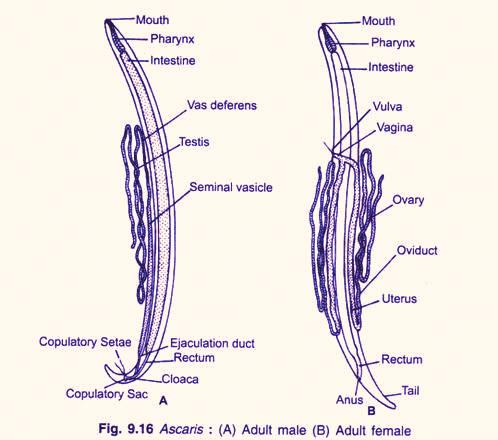
Male and female Ascaris respectively have
(a) Two testes and two ovaries.
(b) Two testes and one ovary.
(c) One testis and two ovaries.
(d) One testis and one ovary.
Answer
589.2k+ views
Hint: Ascaris belongs to the class Nematoda and is unisexual. Females are wide about 20-40 cm long, whereas males are thinner about 15-30 cm long. At the posterior end, female worms are straight while males are hooked.
Complete answer: Male Ascaris is monarchic, which means it possesses a single testis, while female Ascaris is didelphic which means, it has two ovaries, two oviducts, and two uteri.
Male Reproductive organs of Ascaris consists of the testis, a vas deferens, a seminal vesicle, en ejaculatory duct, cloaca, and penial setae.
The testes are a long, thin highly twisted tube-like structure that continues into a vas deferens. The testis bears a cavity that is lined by a single layer of cuboidal cells. The cavity acts as a “growth zone” as it contains a semi-solid axial core of the rachis of cytoplasm. Around this rachis, the spermatogonia are irregularly attached which progressively undergo maturation or spermatogenesis to form sperms.
Female reproductive organs of Ascaris include ovaries, oviducts, uterus, and vagina.
By budding oogonia are formed from a large single germinal cell. It forms the proximal “germinal zone” of each ovary (growth zone). In this zone oogonia undergoes oogenesis. After compilation of the first maturation division, the oogonia becomes secondary oocytes and reaches the oviducts.

In the figure, A is an adult male and B is an adult female.
So, the correct answer is ‘Ascaris male has one testis and two ovaries’.
Notes:
Ascaris is the most familiar parasite in humans commonly known as” giant intestinal roundworms” More than 25 percent of the world's human population is infected with these worms.
Infestation may lead to morbidity, and sometimes death. By compromising nutritional status and affecting cognitive processes, such as tissue reactions, and provoking intestinal obstruction.
Complete answer: Male Ascaris is monarchic, which means it possesses a single testis, while female Ascaris is didelphic which means, it has two ovaries, two oviducts, and two uteri.
Male Reproductive organs of Ascaris consists of the testis, a vas deferens, a seminal vesicle, en ejaculatory duct, cloaca, and penial setae.
The testes are a long, thin highly twisted tube-like structure that continues into a vas deferens. The testis bears a cavity that is lined by a single layer of cuboidal cells. The cavity acts as a “growth zone” as it contains a semi-solid axial core of the rachis of cytoplasm. Around this rachis, the spermatogonia are irregularly attached which progressively undergo maturation or spermatogenesis to form sperms.
Female reproductive organs of Ascaris include ovaries, oviducts, uterus, and vagina.
By budding oogonia are formed from a large single germinal cell. It forms the proximal “germinal zone” of each ovary (growth zone). In this zone oogonia undergoes oogenesis. After compilation of the first maturation division, the oogonia becomes secondary oocytes and reaches the oviducts.

In the figure, A is an adult male and B is an adult female.
So, the correct answer is ‘Ascaris male has one testis and two ovaries’.
Notes:
Ascaris is the most familiar parasite in humans commonly known as” giant intestinal roundworms” More than 25 percent of the world's human population is infected with these worms.
Infestation may lead to morbidity, and sometimes death. By compromising nutritional status and affecting cognitive processes, such as tissue reactions, and provoking intestinal obstruction.
Recently Updated Pages
The number of solutions in x in 02pi for which sqrt class 12 maths CBSE

Write any two methods of preparation of phenol Give class 12 chemistry CBSE

Differentiate between action potential and resting class 12 biology CBSE

Two plane mirrors arranged at right angles to each class 12 physics CBSE

Which of the following molecules is are chiral A I class 12 chemistry CBSE

Name different types of neurons and give one function class 12 biology CBSE

Trending doubts
One Metric ton is equal to kg A 10000 B 1000 C 100 class 11 physics CBSE

Explain zero factorial class 11 maths CBSE

What is 1s 2s 2p 3s 3p class 11 chemistry CBSE

Discuss the various forms of bacteria class 11 biology CBSE

State the laws of reflection of light

Difference Between Prokaryotic Cells and Eukaryotic Cells




